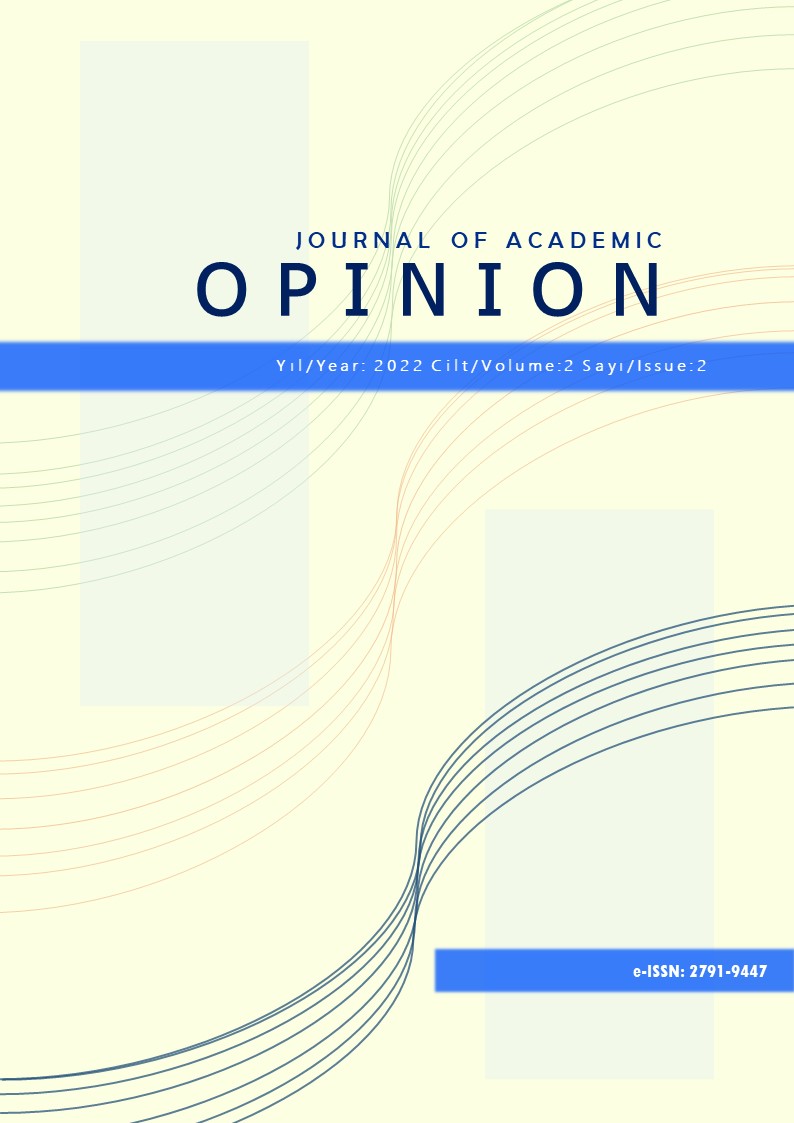Çalışanların Kamu Kurumlarında Sanal Kaytarma Davranışına Yönelik Düşüncelerinin İncelenmesi
Anahtar Kelimeler:
Sanal Kaytarma, İşle İlgili Olmayan Faaliyet, İş Dışı İnternet KullanımıÖzet
Bilişim Çağı olarak adlandırılan çağımızda, bilişim ve iletişim alt yapısı teknolojik gelişmelerle birlikte geniş coğrafyalara yayılmıştır. Bireyler veya kurumlar birbirleriyle veri ve enformasyon alışverişinde, özellikle iletişim ve bilgisayar ağları ile önemli kazanımlar elde etmiştir. İnternet, kamu kurumlarında vazgeçilmez bir amaca hizmet etmesine karşın çalışanların iş dışı alanlarda eylemde bulunmasına da kolaylık sağlamıştır. Personelin iş yerinde kişisel amaçları doğrultusunda internet kullanımları sanal kaytarma olarak adlandırılmaktadır. Kişilerin bu eylemi gerçekleştirmelerinde etkisi olan faktörlerin belirlenmesi kurumlar tarafından gün geçtikçe daha fazla önemsenir hale gelmiştir. Bu çalışma ile kamu kurumlarında çalışan personelin sanal kaytarma eylemine yönelik düşüncelerinin çeşitli değişkenlere (cinsiyet, yaş vb.) göre farklılık gösterip göstermediğinin belirlenmesi amaçlanmıştır. Araştırmada veri toplama aşamasında araştırmacılar tarafından geliştirilen “Sanal Kaytarma Ölçeği” ile kişisel bilgi formu kullanılmıştır. Çalışmada araştırma yöntemi olarak “Betimsel Yöntem” tercih edilmiştir. Sivas ilindeki kamu kurumlarında kadrolu, sözleşmeli veya işçi statüsünde çalışan ve 18 yaş veya üzerinde bulunan kişiler araştırmanın evrenini, yüz yüze veya online olarak kolayda örnekleme yöntemi ile ulaşılan 490 kişi ise çalışma grubunu oluşturmaktadır. Araştırma verilerinin analizi SPSS 25.0 istatistik paket programıyla yapılmıştır. Elde edilen verilerin dağılımlarının normal olmadığı Kolmogorov-Smirnov Normallik Testi sonucunda belirlenmiş ve nonparametrik istatistiksel yöntemlerden (Kruskal Wallis H Testi, Mann Whitney U Testi, Bonferroni Düzeltmeli Mann Whitney U Testi) yararlanılmıştır. Çalışma sonucunda katılımcıların büyük çoğunluğunun interneti mesai saatleri içerisinde bireysel amaçlar için kullanmayı kabul edilebilir bir durum olarak gördüğü; teknolojik araçları (bilgisayar, akıllı cep telefonu, tablet vb.) kullanma beceri seviyelerinin iyi düzeyde olduğu; iş dışında internet ve bilgisayarı bir veya iki saat arasında kullandığı belirlenmiştir. Ayrıca katılımcıların sanal kaytarmaya yönelik düşüncelerinde cinsiyet, medeni durum, internetin kişisel amaçlar için kullanımı, yaş, eğitim durumu, istihdam durumu, aylık gelir ve kamu kurumlarında çalışma süresi değişkenlerine göre anlamlı farklılıklar olduğu saptanmıştır.
Referanslar
Akca, A. (2013). Okul Yöneticilerinin İş Dışı İnternet Kullanım (Siber Aylaklık) Davranışlarının İncelenmesi. Yayınlanmamış Yüksek Lisans Tezi, İstanbul: Yıldız Teknik Üniversitesi Sosyal Bilimler Enstitüsü.
Altunışık, R., Coşkun, R., Bayraktaroğlu, S. ve Yıldırım, E. (2012). Sosyal Bilimlerde Araştırma Yöntemleri, Sakarya: Sakarya Yayıncılık, 7. Baskı.
Anandarajan, M., Simmers, C. ve Igbaria, M. (2000). An Exploratory Investigation of the Antecedents and Impact of Internet Usage: An Individual Perspective. Behaviour and Information Technology, 19(1): 69-85.
Anandarajan, M., Simmers, C. A., ve D'Ovidio, R. (2011). Exploring the underlying structure of personal web usage in the workplace. Cyberpsychology, behavior, and social networking, 14(10): 577-583. doi: 10.1089/cyber.2010.0136.
Arslan, T. E. ve Demir, H. (2016), Sanal Kaytarma: Bir Kamu Kurumunda Hemşireler Üzerinde Ampirik Bir Araştırma. Journal of International Social Research, 9(43): 1626-1626. doi: 10.17719/jisr.20164317733.
Askew, K., Buckner, J., Taing, M., Ilie, A., Bauer, J. ve Coovert, M. (2014). Explaining Cyberloafing: The Role of The Theory of Planned Behavior. Computers in Human Behavior, 36: 510-519.
Avcı, Y. E., Demir, S. ve Üce, Ö. (2022). İdari Personelde Sanal Kaytarma Davranışı İle İş Performansı İlişkisi. Journal of History School, 58: 2087-2103.
Bayer, N. (2021). Hemşirelerde Sanal Kaytarma Davranışının İncelenmesi: Bir Özel Hastane Örneği. Turkish Journal of Science and Health, 2(1): 139-145. https://dergipark.org.tr/en/pub/tfsd/issue/60096/841817.
Blanchard, A.L. ve Henle, C.A. (2008). Correlates of Different Forms of Cyberloafing: The Role of Norms and External Locus of Control. Computers in Human Behavior, 24(3): 1067-1084.
Bock, G. W. ve Ho, S. L. (2009). Non-work related computing (NWRC). Communications of the ACM, 52(4): 124-128. Doi:10.1145/1498765.1498799.
Chak, K. (2003), Shyness and Locus of Control as Predictors of Internet Addiction and Internet Use, A Graduation Project in Partial Fulfillment of the Requirement for the Degree of Master of Science in New Media, The Chinese University of Hong Kong.
Çavuşoğlu, S., Palamutçuoğlu, A. ve Palamutçuoğlu, B.T. (2014). Çalışanların Demografik Özelliklerinin Sanal Kaytarma (Cyberloafing) Üzerindeki Etkisi: Üniversite Çalışanları Üzerinde Ampirik Bir Araştırma. Research Journal of Business and Management, 9(19): 149-168.
Çelik, N. (2014). Job Satisfaction’s Impact On Cyberloafing: An University Example. 10th International Academic Conference, Haziran, Viena.
Demir, İ.P., Ürek, D. ve Uğurluoğlu, Ö. (2017). Sağlık çalışanlarının sanal kaytarma davranışının işte üretkenliklerine etkisi. Online Academic Journal of Information Technology, 8(30): 291-303.
Durmuş, Ş. ve Çelik, A. (2020). Sanal Kaytarma Davranışları ve Zaman Yönetimi Etkileşimi: Karamanoğlu Mehmetbey Üniversitesi Araştırma Görevlileri Örneği. Aksaray Üniversitesi İktisadi ve İdari Bilimler Fakültesi Dergisi, 12(1): 79-86.
Garrett, R. K. ve Danziger, J. N. (2008). Disaffection or Expected Outcomes: Understanding Personal Internet Use During Work. Journal of Computer-Mediated Communication, 13: 937-958.
Güler, A. & Güner, Y. (2022) Kamu Kurumlarında Sanal Kaytarmaya Yönelik Bir Ölçek Geliştirme Çalışması. İşletme Bilimi Dergisi, 10(2), 247-274.
Gültekin, D. ve Ulusoy, H. (2022). Sağlık Çalışanlarında Sanal Kaytarma ve Örgütsel Güven Arasındaki İlişkinin Belirlenmesi. Journal of Healthcare Management and Leadership, (1): 70-97. doi: 10.35345/johmal.1091046.
Hoşgör, H. , Coşkun, F. , Cin, S. ve Ülker Dörttepe, Z. (2021). Hemşirelerin Sanal Kaytarma Davranışlarının, Hizmet Verme Yatkınlıkları Üzerindeki Etkisinin İncelenmesi. Uluslararası Sağlık Yönetimi ve Stratejileri Araştırma Dergisi, 7(2): 366-376. https://dergipark.org.tr/en/pub/usaysad/issue/64697/988581.
Jackson, L. A., Ervin, K. S., Gardner, P. D. ve Schmitt, N. (2001). Gender and the Internet: Women Communicating and Men Searching. Sex Roles, 44: (5/6), 363-379.
Kaplan, M. ve Çetinkaya, A. ġ. (2014). Sanal Kaytarma ve Demografik Özellikler Açısından Farklılıklar: Otel İşletmelerinde Bir Araştırma. Anatolia: Turizm Araştırmaları Dergisi, 25(1): 26-34.
Karaoğlan Yılmaz, F. G., Yılmaz, R., Özturk, H. T, Sezer, B. ve Karademir, T. (2015). Cyberloafing as a Barrier to the Successful Integration of Information and Communication Technologies into Teaching and Learning Environments. Computers in Human Behavior, 45: 290-298.
Koç, K. ve Altuntaş, S. (2021). Sağlık çalışanlarında sanal kaytarma davranışları. Sağlık ve Hemşirelik Yönetimi Dergisi, 8(2): 284-292.
Küçük, F. ve Nur, E. (2019). Sanal Kaytarma Davranışları İle İş Verimliliği Arasındaki İlişki: Harran Üniversitesinde Çalışan Akademik ve İdari Personel Üzerine Bir Araştırma. International Social Science Journal, 12(66): 1102-1116. doi: 10.17719/jisr.2019.3656.
Lee, Z., Lee, Y. ve Kim, Y. (2004). Personal Web Usage in Organizations. Personal Web Usage in the Workplace: A Guide to Effective Human Resources Management (editörler: M. Anandarajan ve C. Simmers), Information Science Publishing.
Lim, V. K. (2002). The IT way of loafing on the job: cyberloafing, neutralizing and organizational justice. Journal of Organizational Behavior, 23(5): 675-694.
Lim, V. K. ve Chen, D. J. (2012). Cyberloafing at the Workplace: Gain or Drain on Work?. Behaviour & Information Technology, 31(4): 343-353, doi:10.1080/01449290903353054.
Lim, V. K. ve Teo, T. S. (2005). Prevalence, perceived seriousness, justification and regulation of cyberloafing in Singapore: An exploratory study. Information & Management, 42(8): 1081-1093. https://doi.org/10.1016/j.im.2004.12.002.
Morahan-Martin, J. (2001). Caught in the Web: Research and Criticism of Internet Abuse with Application to College Students, Learning and teaching on the World Wide Web, (editör: C. R. Wolfe), 191-219, Academic Pres, San Diego, CA, aktaran: Liberman, B. Seidman, McKenna, G. K. ve Buffardi, L. E. (2011) Employee Job Attitudes and Organizational Characteristics as Predictors of Cyberloafing. Computers in Human Behavior, 27: 2192-2199.
Örücü, E. ve Yıldız, H. (2014). İşyerinde kişisel internet ve teknoloji kullanımı: Sanal kaytarma. Ege Akademik Bakış, 14(1): 99-114. https://dergipark.org.tr/en/download/article-file/560040.
Özdem, G. ve Demir, A. (2015). Okul Yöneticilerinde Sanal Kaytarma Davranışı . Mersin Üniversitesi Eğitim Fakültesi Dergisi, 11(3): 1030-1042. https://dergipark.org.tr/en/pub/mersinefd/issue/17398/182040.
Özkalp, E., Aydın, U. ve Tekeli, S. (2012). Sapkın Örgütsel Davranışlar ve Çalışma Yaşamında Yeni Bir Olgu: Sanal Kaytarma (Cyberloafing) ve İş İlişkilerine Etkileri. Çimento İşveren Dergisi, 26(2): 18-33.
Ramayah, T. (2010). Personal Web Usage and Work Inefficiency. Business Strategy Series, 11(5): 295-301.
Sadıç, E. , Eğilmez, Ö. ve Haşit, G. (2020). Üniversite Çalışanları Bağlamında Sanal Kaytarma ve Örgütsel Vatandaşlık Davranışı Üzerine Bir İnceleme. Bilecik Şeyh Edebali Üniversitesi Sosyal Bilimler Dergisi, 5(2): 234-256. doi: 10,33905/bseusbed.777522.
Tabachnick, B. G. ve Fidell, L. S. (2007). Using Multivariate Statistics, Boston MA: Allyn & Bacon, (Hale, I. (2015). Ergenler İçin Oyun Bağımlılığı Ölçeğinin Türkçe’ye Uyarlama Çalışması, Elementary Education Online, 14(2): 874-884.
Tavşancıl, E. (2010). Tutulumların Ölçülmesi ve SPSS ile Veri Analizi, Ankara: Nobel Basım Yayın, 4. Baskı.
Ugrın, J. C., Pearson, J. M. ve Odom, M. D. (2008). Profiling Cyber-Slackers in the Workplace: Demographic, Cultural, and Workplace Factors. Journal of Internet Commerce, 6(3): 75-89.
Ünal, F. ve Tekdemir, S. (2015). Sanal kaytarma: Bir kamu kurumunda ampirik bir araştırma. Süleyman Demirel Üniversitesi İktisadi ve İdari Bilimler Fakültesi Dergisi, 20(2): 97-99. https://dergipark.org.tr/tr/download/article-file/194136.
Ürek, D. , Bilgin Demir, İ. ve Uğurluoğlu, Ö. (2018). Sağlık Çalışanlarının Sanal Kaytarma Davranışlarının İncelenmesi: Bir Üniversite Hastanesi Örneği. Anadolu Üniversitesi Sosyal Bilimler Dergisi, 18(2): 135-148. doi: 10.18037/ausbd.552423.
Vıtak, J., Crouse, J. ve La Rose, R. (2011). Personal Internet Use at Work: Understanding Cyberslacking. Computers in Human Behavior, 27: 1751-1759.
Wallace, P. (2004). The Internet in the Workplace: How New Technology is Transforming Work (1st Edition). Cambridge University Press.
Weissenfeld, K., Abramova, O. ve Krasnova, H. (2019). Antecedents for cyberloafing- A literatüre review. International Conference on Wirthschaftsinformatiki, 1687-1701.
Yıldırım, E. ve Öztürk, U. (2022). Örgütsel Davranışlarda Ölçek Araştırmaları: Sanal Kaytarma. Eğitim Yayınevi. E-book.
İndir
Yayınlanmış
Nasıl Atıf Yapılır
Sayı
Bölüm
Lisans
Telif Hakkı (c) 2022 Journal of Academic Opinion

Bu çalışma Creative Commons Attribution 4.0 International License ile lisanslanmıştır.





